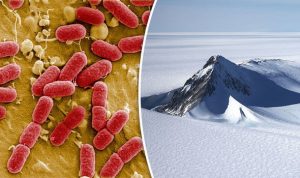For the first time scientists have directly observed Living bacteria in polar ice and snow — an environment
once considered sterile. The new evidence has the potential to alter perceptions about which planets in
the universe
could sustain life and may mean that humans are having an even greater impact on levels of CO2 in
Earth’s atmosphere than accepted evidence from climate history studies of ice cores suggests.

Implications for climate data
“As microbial activity and its influence on its local environment has never been taken into account when
looking at ice-core gas samples, it could provide a moderate source of error in climate history interpretations,”
said lead author Dr Kelly Redeker.
Gases captured and sealed in snow as it compresses into ice can provide researchers with snapshots of
Earth’s atmosphere going back hundreds of thousands of years. Climate scientists use ice core samples to look at
prehistoric levels of CO2 in the atmosphere so they can be compared with current levels in an industrial age.
This analysis of ice cores relies on the assumption that there’s limited biological activity altering the environment
in the snow during its transition into ice.
The research, published in the Journal of the Royal Society Interface, revealed that the composition of small
samples of gas trapped in the ice may have been affected by bacteria that remain active in snow while it’s
compressed into ice – a process that can last decades. “As microbial activity and its influence on its
local environment has never taken into account when looking at ice-core gas samples it could
provide a moderate source of error in climate history interpretations,” said Kelly Redeker from the
University of York in the UK.











